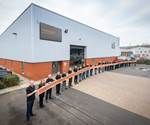Cobham wins Airbus Innovation Award for helicopter antenna integration
The award-winning design is said to integrate multiple antenna functions within the fuselage’s composite in one place.
Share
Read Next
Cobham Aerospace Communications (Dourdan, France) has recently been awarded an Airbus Innovation Award for its work on antenna integration into helicopter fuselage structures.
The award-winning design is said to integrate multiple antenna functions within the fuselage’s composite in one place, instead of as many as 20 externally mounted antennas per helicopter, each with complex installation challenges. In the future, aircraft manufacturers will be able to acquire the composite structures with Cobham antennas embedded inside, meaning fewer part numbers to procure and assemble, the company says. This will lead to quicker production times, elimination of physical damage to external antennas and a more streamlined aesthetic for reduced drag.
“Cobham is committed to working with partners like Airbus to help keep them at the cutting edge of aircraft innovation,” says Paul Kahn, president of Cobham Communications and Connectivity. “This technology has applications beyond helicopters, on fixed wing aircraft and [unmanned aerial vehicles] UAVs, where it has the potential to deliver substantial fuel and emissions savings. We look forward to announcing its use on other airframes soon.”
Related Content
-
Manufacturing the MFFD thermoplastic composite fuselage
Demonstrator’s upper, lower shells and assembly prove materials and new processes for lighter, cheaper and more sustainable high-rate future aircraft.
-
Cryo-compressed hydrogen, the best solution for storage and refueling stations?
Cryomotive’s CRYOGAS solution claims the highest storage density, lowest refueling cost and widest operating range without H2 losses while using one-fifth the carbon fiber required in compressed gas tanks.
-
ASCEND program update: Designing next-gen, high-rate auto and aerospace composites
GKN Aerospace, McLaren Automotive and U.K.-based partners share goals and progress aiming at high-rate, Industry 4.0-enabled, sustainable materials and processes.

.jpg;width=70;height=70;mode=crop)











